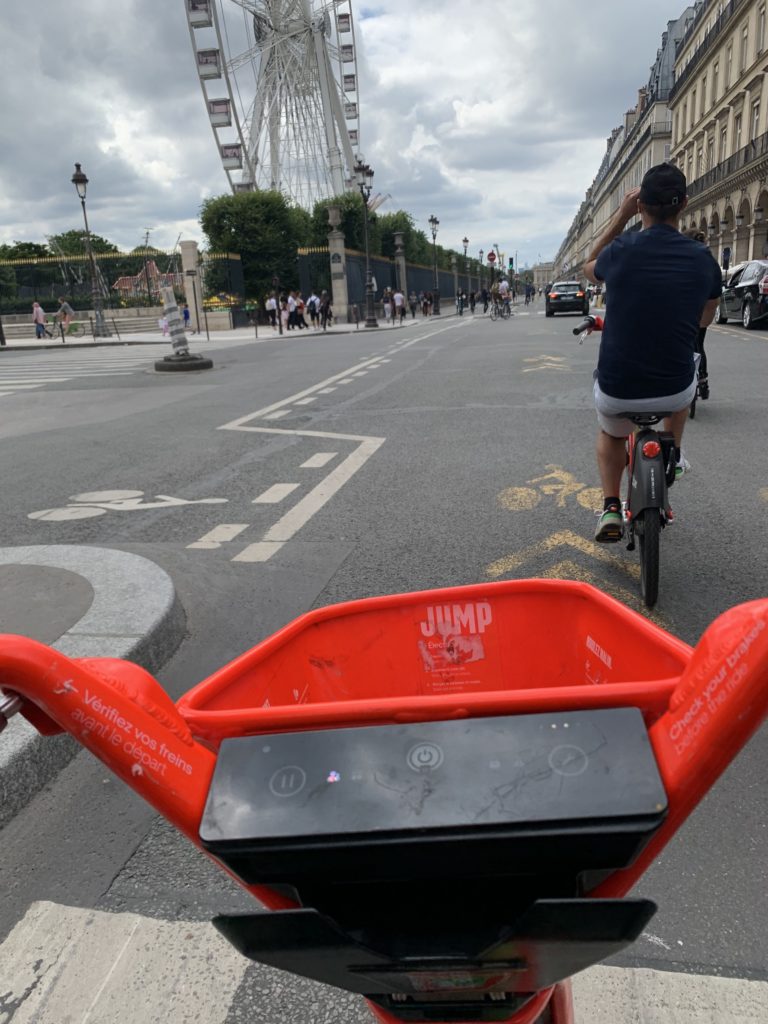For the past few months, I have been enjoying a digital nomad life, trying mobility services across EU cities. Brussels, Malaga, Lille, Tenerife, London, Nice, Barcelona, Cannes and Paris offered contrasting experiences. My goal was to leave my mobility consultant hat and step in the end-users shoes. My last trip in the French capital was the trigger to write this post because I faced so much pleasure and frustrations at the same time. Here is my feedback:
Travel across countries and cities. Experience: 10/10!
Booking flights/trains and accommodations were super smooth with Google Flights/Trainline and Airbnb – Good job guys! Travels across countries despite Covid-19 were easy, well-done to all the people working hard to keep us moving while ensuring our safety.
Arriving at destination – Hey ho, who’s there?! Experience: 5/10
At my destinations, things are getting complicated. Which mobility operators can I use here? I start what’s now a ritual: I open dozens of apps to check who’s there.
I wish there were an ad, a user-friendly mobility operator database, an app notification or even a guy with flyers waiting outside of the airport/station making me aware of how I can move where I arrived.
Conclusion: half of the time when I arrive in a city, I am in a hurry and in the end I ride with a traditional taxi or public transport service because I know where and how to use the service.
Using mobility services. Excellent ridehailing and carsharing. Experience: 8/10
Now I know which company I can travel with. Great, let’s ride. Overall, my experiences with ridehailing and carsharing companies are good. Sometimes the waiting time could be a bit long and some drivers cancelled trips but it is enough anecdotical for me to go over it and ride again.
Micromobility services: Contrasted satisfaction. Experience: 6/10
But ridehailing and carsharing are also expensive and inconvenient enough (i.e. congestion, parking…) to be ad-hoc services during my urban stays. So I’ll focus here on services I used the most because these limitations forced me to look for alternatives: micromobility.
In short, my feelings are a mix of frustration and excitement. Once riding vehicles, I was very pleased with the quality of the devices. Good bikes, fun scooters and efficient mopeds across providers and cities. The frustration came from everything that happened BEFORE the ride in my customer journey.

Mobile apps are most of the time meeting my expectations: good localization, easy to identify nearest vehicles, nice tracking of my orders and journey, and smooth payments. Hence, the pain point does not come from the tech nor the vehicle but from the service. For trips longer than 10 km, I do not remember I was able to complete the journey with the same vehicle. Low charge and broken stuff most of the time pushed me (and my friends who accompanied me) to park the vehicle and look for another one. Even worse, I do not count the number of times I was looking for ghost or unlabeled vehicles which was a huge loss of time.
For trips longer than 10 km, I do not remember I was able to complete the journey with the same vehicle because of low charge and broken stuff.
Micromobility conclusion: Better tech, great vehicles but same issues.
While clearly mobility services have expanded to lots of new cities, few years after my first shared bike and scooter rides, I am facing the same frustrations as a user. Perhaps issues are copied and pasted across cities without solutions or mobility operators hope that volume will eventually solve problems. The reality is the tech and vehicles are much better but issues remain the same. Hence, I wonder how much improving and investing in tech have concretely improved user experience.
I wonder how much improving and investing in tech have concretely improved user experience.
Public transports still at the top.
How did I end up balancing frustrations? I came back to classic public transports when I was in a hurry. In the end, it was the most efficient and cost-effective way for me to get fast and safely somewhere in these cities I was not familiar with. I include in the list public bike-sharing schemes such as Velib in Paris which offered me a much better experience (availability, reliability, and price transparency) compared to other ones from private shared bike providers.
And when I was more relaxed, I enjoyed fresh rides with bikes, scooters and mopeds.

Classic public transports were in the end the most efficient and cost-effective way for me to get fast and safely somewhere in these cities.
In the end, I loved this mix because it brought lots of diversity in my trips and mini excitements every time I had to choose for my mode of transport.
My takeaways: Privately-run mobility services may be limited, apps offer low value and investors should encourage simplicity over uniqueness.
What are my takeaways and questions raised so far?
First, massive congratulations to cities being bold enough to kick cars out and give space for other modes. Special clap for Paris and Brussels, I sometimes barely recognized some streets even despite the fact I spent most of my childhood there… Experience: 20/10!

Second, great tech and vehicles are not enough to give access and ensure good experience to users. Hence, what’s missing and are we focusing on the real value added for users? Perhaps an answer in my next point.
Third, I could clearly feel that mobility services are built from an investor pitch deck perspective. Most players offer great machines and amazingly complex mobile apps but outside of my smartphone, I faced lots of frustrations related to the service itself. I have then two comments.
Mobility services are built from an investor pitch deck perspective. Asset over service, complexity and uniqueness over simplicity and interoperability.
One, I feel like these companies had the obligation to propose good vehicles and to develop unnecessarily sophisticated platforms to attract investors because most likely very few would have raised money if in the investor pitch the proposed solution was basic. I have a bit of experience when it comes to pitch in front of investors a service powered by platform/software. In short, you raise more money for the asset you acquire/develop, less for the service you deliver. Which is a shame as mobility is above all a service in my opinion. Of course, the SPAC wave promising fortune for anyone bringing a fancy product does not help to keep things simple.
Two, mobility is becoming a synonym of mobile app. But do we need apps? I do not question the value for car-based shared mobility services but for micromobility, frankly the only moment I needed an app was to locate my vehicle. For the rest, it is useless, even for payment. If there were a contactless pad like in a London bus, I would swap my card or smartphone and hop, on the bike. I can only imagine the immense resources invested to make these apps sexy and user friendly, which they are (!), whereas these resources could be invested in the service, where the real issue is.
Mobility is becoming a synonym of mobile app. But do we need apps?
Fourth, when I compare my satisfaction level between comparable public and private services (e.g. Velib vs Lime), most of the time I was better off with a publicly-run service. This raises the question: To be efficient, should mobility operators be exclusively private? What about more collaboration with public authorities (PPP?)? Most, if not all, micromobility services are struggling to be profitable. But what about the benefits (i.e. externalities) generated thanks to these services that operators do not capture? Less pollution, better access to congested areas bringing more customers for shopping or tourism activities and improved health from active mobility are significant sources of benefits captured by public authorities and local businesses that mobility companies cannot charge for.
Micromobility companies struggle to be profitable but cannot capture important benefits directly generated from their services. Fair for them?
Perhaps Mobility is meant to be unprofitable because it serves a bigger and more important purpose where social, economic and environmental profits are much greater? Hence, how can we fairly distribute these benefits?
What next for me? First, keep looking for answers to questions raised here. Second, several EU cities are under my radar for this summer where I’ll keep trying services.
Clearly the mobility ecosystem is moving towards the right direction but some adjustments are still needed. I cannot stress again enough about the importance to think about customer experience over the rest.
Well done to everybody making this industry everyday a bit more essential and effective in the mission to build a more livable world.
PS: Now that I have written this article, I realize the only pictures I have to illustrate my points are from Paris. I’ll share more pics next time folks and sorry for that!

